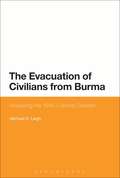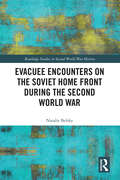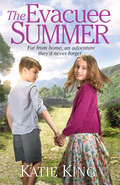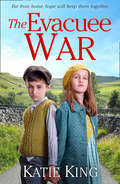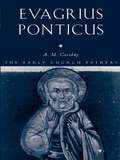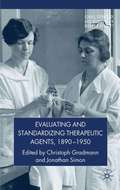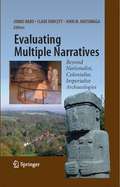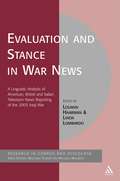- Table View
- List View
The Evacuation of Civilians from Burma: Analysing the 1942 Colonial Disaster
by Michael D. LeighThe string of military defeats during 1942 marked the end of British hegemony in Southeast Asia, finally destroying the myth of British imperial invincibility. The Japanese attack on Burma led to a hurried and often poorly organized evacuation of Indian and European civilians from the country. The evacuation was a public humiliation for the British and marked the end of their role in Burma.The Evacuation of Civilians from Burma investigates the social and political background to the evacuation, and the consequences of its failure. Utilizing unpublished letters, diaries, memoirs and official reports, Michael Leigh provides the first comprehensive account of the evacuation, analyzing its source in the structures of colonial society, fractured race relations and in the turbulent politics of colonial Burma.
The Evacuation of Civilians from Burma: Analysing the 1942 Colonial Disaster
by Michael D. LeighThe string of military defeats during 1942 marked the end of British hegemony in Southeast Asia, finally destroying the myth of British imperial invincibility. The Japanese attack on Burma led to a hurried and often poorly organized evacuation of Indian and European civilians from the country. The evacuation was a public humiliation for the British and marked the end of their role in Burma.The Evacuation of Civilians from Burma investigates the social and political background to the evacuation, and the consequences of its failure. Utilizing unpublished letters, diaries, memoirs and official reports, Michael Leigh provides the first comprehensive account of the evacuation, analyzing its source in the structures of colonial society, fractured race relations and in the turbulent politics of colonial Burma.
Evacuee Boys: Letters of a Family Separated by War (History Press Ser.)
by John E. ForbatBrothers John and Andrew Forbat had been happily living in England as patriotic British boys since 1936. When the Second World War broke out, however, the brothers found themselves evacuated to a disadvantaged part of Melksham in Wiltshire, cut off from home and family, and in straitened circumstances. Added to this, on Pearl Harbor Day 1941, Hungary, along with other countries, joined the Axis and the Forbat family became Enemy Aliens. Their many letters home throughout the war, with details of their schooling, bullying, friendships and constant pursuit of more pocket money, form a humorous and at times tragic testament to the hardships of war. Interspersed with diary entries made by the boys’ father back home in Blitz-ravaged London, and letters from Andrew when he was interned on the Isle of Man, Evacuee Boys is as full a record of war-torn Britain as one family could provide.
The Evacuee Christmas
by Katie KingA heart-warming story of friendship and family during the first Christmas of World War Two.
Evacuee Encounters on the Soviet Home Front During the Second World War (Routledge Studies in Second World War History)
by Natalie BelskyThis study is the first to examine the experiences of the millions of Soviet civilians evacuated to the interior of the country during the Second World War in the context of their encounters and relations with local communities and populations across Soviet Central Asia, Kazakhstan, Siberia, and the Urals. The book considers the impact of this episode of massive population displacement across Eurasia on individuals, communities, and society more broadly. It explores how the challenges associated with wartime displacement gave rise to tensions between evacuees and local residents. These frictions, in turn, forced individuals to interrogate the meaning, terms, and limitations of citizenship and belonging in the Soviet Union. Evacuation thus played a critical role in the changing relationship between citizens and the Soviet state in the war and postwar periods. Furthermore, this study pays particular attention to the plight of Soviet Jewish evacuees, who constitute the largest contingent of Holocaust survivors in Europe, and the rise of anti-Semitism on the Soviet home front during the war. This volume will be of interest to students and scholars of the Second World War, migration and displacement, the Holocaust, Soviet Jewish history, and the Soviet experience more broadly.
Evacuee Encounters on the Soviet Home Front During the Second World War (Routledge Studies in Second World War History)
by Natalie BelskyThis study is the first to examine the experiences of the millions of Soviet civilians evacuated to the interior of the country during the Second World War in the context of their encounters and relations with local communities and populations across Soviet Central Asia, Kazakhstan, Siberia, and the Urals. The book considers the impact of this episode of massive population displacement across Eurasia on individuals, communities, and society more broadly. It explores how the challenges associated with wartime displacement gave rise to tensions between evacuees and local residents. These frictions, in turn, forced individuals to interrogate the meaning, terms, and limitations of citizenship and belonging in the Soviet Union. Evacuation thus played a critical role in the changing relationship between citizens and the Soviet state in the war and postwar periods. Furthermore, this study pays particular attention to the plight of Soviet Jewish evacuees, who constitute the largest contingent of Holocaust survivors in Europe, and the rise of anti-Semitism on the Soviet home front during the war. This volume will be of interest to students and scholars of the Second World War, migration and displacement, the Holocaust, Soviet Jewish history, and the Soviet experience more broadly.
The Evacuee Summer
by Katie King‘A heartwarming read’ My Weekly ‘A delightful, nostalgic read’ Woman Magazine Far from home, an adventure they’ll never forget…
The Evacuee War
by Katie KingFar from home, hope will keep them together. The plucky evacuees must come together in this heart-warming saga set in the Second World War for fans of Dilly Court and Rosie Goodwin…
Evacuees: Evacuation in Wartime Britain 1939-1945 (Shire Library)
by Mike BrownMike Brown combines factual narrative with contemporary eyewitness accounts and oral history extracts to look at the evacuation in Britain during the Second World War.
Evader: The Epic Story of the First British Airman to be Rescued by the Comete Escape Line in World War II (Spellmount Ser.)
by Derek ShuffIn 1941 air gunner Sergeant Jack Newton’s Wellington is hit by flak on his first bombing raid over Germany. Miraculously, the skipper makes an emergency landing on a German-occupied Belgian airfield, narrowly avoiding Antwerp Cathedral. Having torched the plane, the crew give the unsuspecting Germans the slip and are hidden by the Resistance. Hoping to make it to the coast and back across the Channel, the airmen are surprised when the 23-year-old female leader of the Comete Escape Line, Andree de Jongh – codenamed Dedee – has other plans for them. Full of terrifying and humorous moments, this is the story of the epic journey of the first British airman to escape occupied Europe during the Second World War.
Evagrius of Pontus: The Gnostic Trilogy
by Robin Darling Young Joel Kalvesmaki Columba Stewart Charles M. Stang Fr. Luke DysingerThe Gnostic Trilogy is the best-known and most important work by the ascetic philosopher and teacher Evagrius of Pontus. Among the writers of his age, Evagrius stands out for his short, perplexing, and absorbing aphorisms, which provide sharp insight into philosophy, Scripture, human nature, and the natural world. The first part of the trilogy, the Praktikos (The Practiced One), provides a diagnosis and treatment of the eight tempting thoughts. It was a foundational text for monastic asceticism and was the basis for the later Seven Deadly sins tradition. The second, Gnostikos (The Knower), explains how someone who has mastered the body and mental delusions should teach others. The third, longest, and most controversial, the Kephalaia gnostika (Gnostic Chapters), ranges broadly over the origin of the universe, the nature of rational beings, and the hidden symbols of Scripture. This part was responsible for Evagrius's condemnation as a heretic and, as a result, does not survive intact in the original Greek and must be restored from ancient translations. This volume presents the Trilogy in its entirety for the first time since antiquity and provides a fresh, comprehensive English translation of all three works, in all their known ancient versions, both Greek and Syriac. Detailed explanatory notes, cross-references to Scripture, to ancient literature, and to Evagrius's other writings, as well as commentary on the translation techniques of the Syriac translators, provide the necessary resources for understanding this significant but puzzling text.
Evagrius of Pontus: The Gnostic Trilogy
by Robin Darling Young Joel Kalvesmaki Columba Stewart Charles M. Stang Fr. Luke DysingerThe Gnostic Trilogy is the best-known and most important work by the ascetic philosopher and teacher Evagrius of Pontus. Among the writers of his age, Evagrius stands out for his short, perplexing, and absorbing aphorisms, which provide sharp insight into philosophy, Scripture, human nature, and the natural world. The first part of the trilogy, the Praktikos (The Practiced One), provides a diagnosis and treatment of the eight tempting thoughts. It was a foundational text for monastic asceticism and was the basis for the later Seven Deadly sins tradition. The second, Gnostikos (The Knower), explains how someone who has mastered the body and mental delusions should teach others. The third, longest, and most controversial, the Kephalaia gnostika (Gnostic Chapters), ranges broadly over the origin of the universe, the nature of rational beings, and the hidden symbols of Scripture. This part was responsible for Evagrius's condemnation as a heretic and, as a result, does not survive intact in the original Greek and must be restored from ancient translations. This volume presents the Trilogy in its entirety for the first time since antiquity and provides a fresh, comprehensive English translation of all three works, in all their known ancient versions, both Greek and Syriac. Detailed explanatory notes, cross-references to Scripture, to ancient literature, and to Evagrius's other writings, as well as commentary on the translation techniques of the Syriac translators, provide the necessary resources for understanding this significant but puzzling text.
Evagrius Ponticus (The Early Church Fathers)
by Augustine CasidayPresenting many texts available for the very first time, this new volume in the successful Early Church Fathers series showcases full translations of Evagrius' letters, notes on various books of the bible, his treatises and his 'chapters'. Augustine Casiday's material is both accurate and refreshingly approachable, and the work is prefaced by a solid introductory essay that presents Evagrius, his work and influences, and modern scholarship in an easy-to-understand way for beginners. For students dealing with Evagrius for the first time, they could not find a better book to begin their exploration of this figure in late-ancient history and theology.
Evagrius Ponticus (The Early Church Fathers)
by Augustine CasidayPresenting many texts available for the very first time, this new volume in the successful Early Church Fathers series showcases full translations of Evagrius' letters, notes on various books of the bible, his treatises and his 'chapters'. Augustine Casiday's material is both accurate and refreshingly approachable, and the work is prefaced by a solid introductory essay that presents Evagrius, his work and influences, and modern scholarship in an easy-to-understand way for beginners. For students dealing with Evagrius for the first time, they could not find a better book to begin their exploration of this figure in late-ancient history and theology.
Evaluating and Standardizing Therapeutic Agents, 1890-1950 (Science, Technology and Medicine in Modern History)
by C. Gradmann J. SimonFollowing the testing of therapeutic sera, the quantified evaluation of a pharmaceutical's efficacy became a key feature of medicine in the twentieth century. The case studies in this volume offer comparisons across Europe, from the diphtheria antitoxin in the late 1800s to the introduction of the Salk polio vaccine in the 1950s.
Evaluating Applied Research: Lessons from Japan (Bloomsbury Academic Collections: Japan)
by John IrvineThe issue of how to achieve value for money from government-funded R&D has over recent years become increasingly important in all industrial nations. The findings of a study which surveys the methods and techniques used to evaluate applied research in Japan are presented. Their analysis determines what lessons can be learned from the approaches to evaluation employed in the main Japanese mission-oriented agencies, in particular MITI and the Science and Technology Agency.
Evaluating Climate Change Impacts (Chapman And Hall/crc Applied Environmental Statistics Ser.)
by Vyacheslav Lyubchich Yulia Gel K. Halimeda Kilbourne Thomas James Miller Nathaniel K. Newlands Adam B. SmithEvaluating Climate Change Impacts discusses assessing and quantifying climate change and its impacts from a multi-faceted perspective of ecosystem, social, and infrastructure resilience, given through a lens of statistics and data science. It provides a multi-disciplinary view on the implications of climate variability and shows how the new data science paradigm can help us to mitigate climate-induced risk and to enhance climate adaptation strategies. This book consists of chapters solicited from leading topical experts and presents their perspectives on climate change effects in two general areas: natural ecosystems and socio-economic impacts. The chapters unveil topics of atmospheric circulation, climate modeling, and long-term prediction; approach the problems of increasing frequency of extreme events, sea level rise, and forest fires, as well as economic losses, analysis of climate impacts for insurance, agriculture, fisheries, and electric and transport infrastructures. The reader will be exposed to the current research using a variety of methods from physical modeling, statistics, and machine learning, including the global circulation models (GCM) and ocean models, statistical generalized additive models (GAM) and generalized linear models (GLM), state space and graphical models, causality networks, Bayesian ensembles, a variety of index methods and statistical tests, and machine learning methods. The reader will learn about data from various sources, including GCM and ocean model outputs, satellite observations, and data collected by different agencies and research units. Many of the chapters provide references to open source software R and Python code that are available for implementing the methods.
Evaluating Climate Change Impacts (Chapman And Hall/crc Applied Environmental Statistics Ser.)
by Vyacheslav Lyubchich, Yulia R. Gel, K. Halimeda Kilbourne, Thomas J. Miller, Nathaniel K. Newlands and Adam B. SmithEvaluating Climate Change Impacts discusses assessing and quantifying climate change and its impacts from a multi-faceted perspective of ecosystem, social, and infrastructure resilience, given through a lens of statistics and data science. It provides a multi-disciplinary view on the implications of climate variability and shows how the new data science paradigm can help us to mitigate climate-induced risk and to enhance climate adaptation strategies. This book consists of chapters solicited from leading topical experts and presents their perspectives on climate change effects in two general areas: natural ecosystems and socio-economic impacts. The chapters unveil topics of atmospheric circulation, climate modeling, and long-term prediction; approach the problems of increasing frequency of extreme events, sea level rise, and forest fires, as well as economic losses, analysis of climate impacts for insurance, agriculture, fisheries, and electric and transport infrastructures. The reader will be exposed to the current research using a variety of methods from physical modeling, statistics, and machine learning, including the global circulation models (GCM) and ocean models, statistical generalized additive models (GAM) and generalized linear models (GLM), state space and graphical models, causality networks, Bayesian ensembles, a variety of index methods and statistical tests, and machine learning methods. The reader will learn about data from various sources, including GCM and ocean model outputs, satellite observations, and data collected by different agencies and research units. Many of the chapters provide references to open source software R and Python code that are available for implementing the methods.
Evaluating Culture: Well-Being, Institutions and Circumstance
by M. JohnsonFrom which evaluative base should we develop policies designed to promote wellbeing among different cultural groups in varying circumstances? This book engages with needs and capabilities to advance normative functionalist assessment of the success with which cultural institutions promote eudaemonic wellbeing in given, determinate circumstances.
Evaluating Multiple Narratives: Beyond Nationalist, Colonialist, Imperialist Archaeologies
by Junko Habu John M. Matsunaga Clare FawcettUsing archaeological case studies from around the world, this volume evaluates the implications of providing alternative interpretations of the past. These cases also examine if multivocality is relevant to local residents and non-Anglo-American archaeologists and if the close examination of alternative interpretations can contribute to a deeper understanding of subjectivity and objectivity of archaeological interpretation.
Evaluating the Cost-Effectiveness of Counselling in Health Care
by Nancy Rowland Keith TolleyLimited resources in health care mean that the value of counselling is decided in a highly competitive economic arena. Keith Tolley and Nancy Rowland have written a practical guide to the basic principles of evaluating cost-effectiveness to enable counsellors and service providers to carry out analysis for themselves. They provide helpful definitions of technical terms and use case studies to demonstrate how to apply the theory in different contexts.
Evaluating the Cost-Effectiveness of Counselling in Health Care
by Nancy Rowland Keith TolleyLimited resources in health care mean that the value of counselling is decided in a highly competitive economic arena. Keith Tolley and Nancy Rowland have written a practical guide to the basic principles of evaluating cost-effectiveness to enable counsellors and service providers to carry out analysis for themselves. They provide helpful definitions of technical terms and use case studies to demonstrate how to apply the theory in different contexts.
Evaluating the Language of Argument (Argumentation Library #37)
by Martin HintonThis book is concerned with the evaluation of natural argumentative discourse, and, in particular, with the language in which arguments are expressed. It introduces a systematic procedure for the analysis and assessment of arguments, which is designed to be a practical tool, and may be considered a pseudo-algorithm for argument evaluation.The first half of the book lays the theoretical groundwork, with a thorough examination of both the nature of language and the nature of argument. This leads to a definition of argumentation as reasoning expressed within a procedure, which itself yields the three frames of analysis used in the evaluation procedure: Process, Reasoning, and Expression. The second half begins with a detailed discussion of the concept of fallacy, with particular attention on fallacies of language, their origin and their effects. A new way of looking at fallacies emerges from these chapters, and it is that conception, together with the understanding of the nature of argumentation described in earlier sections, which ultimately provides the support for the Comprehensive Assessment Procedure for Natural Argumentation.The first two levels of this innovative procedure are outlined, while the third, that dealing with language, and involving the development of an Informal Argument Semantics, is fully described. The use of the system, and its power of analysis, are illustrated through the evaluation of a variety of examples of argumentative texts.
Evaluation and Stance in War News: A Linguistic Analysis of American, British and Italian television news reporting of the 2003 Iraqi war (Corpus and Discourse)
by Louann Haarman Linda LombardoIn a world in which advanced communication technologies have made the reporting of disasters and conflicts (also in the form of breaking news) a familiar and 'normalised' activity, the information we present here about television news reporting of the 2003 war in Iraq has implications that go beyond this particular conflict. Evaluation and Stance in War News functions as a tool kit for the critical evaluation of language in the news, both as raw data in need of interpretation and as carefully packaged products of 'information management' in need of 'unpacking'. The chapters offer an array of theoretical and empirical instruments for revealing, identifying, sifting, weighing and connecting patterns of language use that construct messages. These messages carry with them world views and value systems that can either create an ever wider divide or serve to build bridges between peoples and countries.
Evaluation and Stance in War News: A Linguistic Analysis of American, British and Italian television news reporting of the 2003 Iraqi war (Corpus and Discourse)
by Linda Lombardo Louann HaarmanIn a world in which advanced communication technologies have made the reporting of disasters and conflicts (also in the form of breaking news) a familiar and 'normalised' activity, the information we present here about television news reporting of the 2003 war in Iraq has implications that go beyond this particular conflict. Evaluation and Stance in War News functions as a tool kit for the critical evaluation of language in the news, both as raw data in need of interpretation and as carefully packaged products of 'information management' in need of 'unpacking'. The chapters offer an array of theoretical and empirical instruments for revealing, identifying, sifting, weighing and connecting patterns of language use that construct messages. These messages carry with them world views and value systems that can either create an ever wider divide or serve to build bridges between peoples and countries.
